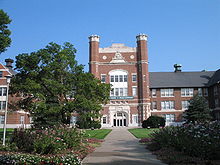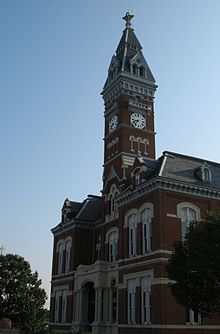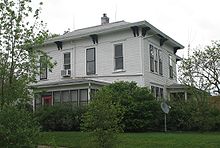- Nodaway County, Missouri
-
Nodaway County, Missouri 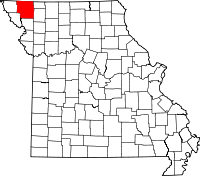
Location in the state of Missouri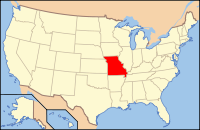
Missouri's location in the U.S.Founded 1845 Named for The Nodaway River Seat Maryville Largest city Maryville Area
- Total
- Land
- Water
877.75 sq mi (2,273 km²)
876.62 sq mi (2,270 km²)
1.13 sq mi (3 km²), 0.13%Population
- (2010)
- Density
23,370
27/sq mi (10.3/km²)Time zone Central: UTC-6/-5 Nodaway County is a county located in the U.S. state of Missouri. The county was organized in 1845 and named for the Nodaway River.
As of 2010, the population was 23,370. Its county seat is Maryville.[1]
It is the largest in area of the counties added to Missouri in the 1836 Platte Purchase, and the fourth largest county in the state of Missouri.
It has a rich agricultural history, including the home of trainers Ben Jones and Jimmy Jones whose horses won six Kentucky Derby races and two Triple Crowns.
The grounds of Northwest Missouri State University make up the official Missouri State Arboretum and were a re-creation of the landscape of the 1904 St. Louis World's Fair. ESPN has carried appearances of the university in five national championship football games, three of which they won.
Supreme Court Justice Clarence Thomas gave up his quest to become a priest while attending Conception Seminary College which also includes a minor basilica. The Benedictine Sisters of Perpetual Adoration convent in neighboring Clyde has 550 relics of saints—the largest collection in the U.S.
Located in Tornado Alley, there have been numerous tornadoes to hit the county, including an F4 tornado on April 10, 1979, that obliterated the town of Braddyville, Iowa just across the county line. Tornadoes have struck two of the county's biggest buildings—the Administration Building on the campus of Northwest Missouri State University and Conception Abbey. The 1881 Hopkins tornado is believed to have been one of the first recorded F5 tornados.
Some sensational murders have drawn attention to the county including a profile by CBS 60 Minutes, as well as movies.
Life in the county was chronicled by native Homer Croy in a series of books, articles, films and Broadway shows in the 1920s and 1930s.
Contents
Etymology
The origin of the name "Nodaway" has been attributed to a Pottawatomie name for "placid", a Dakota Sioux name for "crossed without canoe" and various tribes names for "snake."
Famous politicians
- Herbert Hoover (1874–1964) - The President was never a true county resident but he owned a farm south of Graham.
- Henry L. Jost (1873–1950) - Mayor of Kansas City, Missouri, who arrived in Hopkins aboard an orphan train
- Albert P. Morehouse (1835–1891) - Maryville, Missouri resident who succeeded to governor from 1887 to 1889.
- Forrest C. Donnell (1884–1980) - Native of Quitman, Missouri who was a Republican governor from 1941–1945 and U.S. Senator from 1945-1951.
Famous farms and farmers
Among the famous farms of Nodaway County:
- Herbert Hoover Farm - Herbert Hoover had a farm south of Graham, Missouri. Hoover never actively farmed the land he owned, though he visited in the 1930s after leaving office.
- Jones Horse Racing Dynasty - Horse racing trainers Ben A. Jones and his son Horace A. "Jimmy" Jones had a farm near Parnell, Missouri and retired there. During their tenure at Calumet Farm they trained six Kentucky Derby and two Triple Crown winners. Extensive memorabilia from the racing days are in the Nodaway County Historical Society Museum.
- Bilby Ranch - The Bilby Ranch founded near Quitman, Missouri had holdings throughout the West in the late 19th century and early 20th century and claimed to be second only to the King Ranch in size and a dispute over its cattle reached the United States Supreme Court.
- Faustiana Farm - Isaac N. Prather was one of the first settlers in Nodaway County settling there from Kentucky in 1839 shortly after the Platte Purchase established a farm just west of Maryville, Missouri. Prather imported the famous English thoroughbred Faustus and named his farm Faustiana after this horse. The Townsend family, who had made their fortune from the St. Joseph, Missouri department store Townsend & Wall, used the name for their Percheron, Standardbred and American Saddlebred horses when they owned. Many national champion horses come from the line. The farm is a now Maryville housing subdivision.
- Rancho del Rayo - William Robbins, who made his fortune with the Robbins Lighting Rod company in Maryville, established a ranch near Hopkins, Missouri that claimed to be the biggest ranch in Missouri after the Bilby Ranch dissolution in 1919. Robbins, who was active in Republican politics, hosted numerous political picnics attended by all levels of U.S. senators and Missouri governors.
- R.T. Wright University Farm - Northwest Missouri State University owns a 750 acres (3.0 km2) farm north of the campus (called locally the "North Farm"). Among the research evolving from the farm is the use of global positioning satellites for farming and a biofuel project which garnered US 6149694 for transforming manure into fuel pellets that burn with no odor and does not release dangerous gases. The farm is conducting experiments in genetic combinations for plants. In 2006, Northwest drew the ire of Anheuser-Busch when it proposed a partnership with Ventria to develop genetically altered rice.
Other famous natives
For famous students and teachers at the Maryville college see: Northwest Missouri State University
- Sarah Caldwell - Boston opera diva
- Dale Carnegie - Author of How to Win Friends and Influence People
- Homer Croy - Author and screenwriter who wrote about life in Maryville
- Albert David - Medal of Honor winner for capture of U-505 during World War II
- Edward H. Moore - U.S. Senator in Oklahoma
- Harley Race - professional wrestler
- Marcus Morton Rhoades - cytogeneticist
- Grant Wallace - Writer of the occult
- Jerry Wallace - pop-country singer and actor
Crime in the County
Though one of the attributions for the name is "placid," Nodaway County has a long history of violence.
The first "legal" hanging in Nodaway County occurred in the county seat of Maryville on July 22, 1881. Two brothers, Albert P. and Charles E. Talbott, were hanged after being convicted of murdering their father, Dr. Perry H. Talbott, a noted local physician and author, on September 18, 1880 at his home a mile northwest of Arkoe, the town he co-founded. Dr. Talbott was shot at his home, and died of his injuries the same evening. Following their execution, the men were interred on their father's land. Their tombstone, a vertical column with two hands clasped in friendship, still stands, bearing the inscription, "We Died Innocent."
Omaha Charley, whose legal name was Charles F. Stevens, was the next to hang, though without trial, on December 9, 1884, at one o'clock in the morning. Omaha Charley had shot Hubert Kremey in Hilgert's saloon in Maryville on December 3. Feelings about the shooting ran high; locals considered the killing unjustified and decided to take matters into their own hands. News accounts of the time say that fifty masked men appeared before the jail and demanded Omaha Charley, with James Anderson, then county sheriff, complying, whereupon the vigilantes took Omaha Charley to the East Fourth Street Bridge and hanged him.
One of the most notorious murders in the annals of Nodaway County was Hezekiah "Hez" Rasco, a local farmer's son who was eventually hanged on March 26, 1912 for the murder of Oda Hubbell, his wife Clara, and their two small children, Welton and Jessie, sixteen months before.
Hez Rasco was born October 8, 1880 in Fremont County, Iowa, to James Henry and Lucinda (Pierson) Rasco. He was the sixth son born of eight children during their eighteen years there, and one of three children who would live to adulthood. Hez was 31 years old when he died. Hez's troubles began in 1896 with the first killing for which he would be tried and convicted, that being the murder of thirty-five-year-old Kate (Kirch) Baumli, wife of John Baumli, and mother of three small children, Willie (age 11), Susie (age 7), and a baby, Mary Katherine, of 6 months. Hez Rasco was tried three times for the killing of Mrs. Baumli, despite his confession only five days following the crime. The first two trials resulted in a hung jury, both juries being averse to the hanging of a youthful defendant on the charge of first-degree murder. The third trial would result in a guilty conviction, with Rasco being sentenced to the state penitentiary at Jefferson City for ten years. The Sessions Act of 1895 provided that no minor, having been convicted of a crime, could be sentenced to jail or the penitentiary; however, they could be hanged or sent to reform school. The only way, it seemed, to get to the penitentiary was to be convicted, sentenced to death, with the governor granting a commutation. The Sessions Act of 1897 changed the law, allowing that a minor could be sentenced directly to the pentitentiary.
Hez served just under eight years in prison for Kate's death and was released early for time served and good behavior. Within seven months, Hez Rasco would be returned to the penitentiary, this time for stealing a horse in Buchanan County. He served his time and returned to his father's farm, to which the family had relocated just after the turn of the 20th century, living and working there for a short time.
Hez Rasco and Oda Hubbell became acquainted and following an all-night poker game in a boxcar parked at the Barnard Depot, Oda Hubbell returned to his wife and children in the morning of November 20, 1910. Two days later, Hez Rasco would be arrested and charged with the murder of Oda, age 29; his wife; and their two children Welton, a son aged four, and Jessie, a daughter age 6, at their home. It was Oda Hubbell's murder, however, for which Hez would be tried and subsequently convicted. He was never formally tried for the murders of Mrs. Hubbell or the Hubbell children. Oda Hubbell, it was shown, had been shot with a shotgun outside of the house and his body dragged into the home by his killer. Mrs. Hubbell was bludgeoned to death by the butt of a shotgun. The cause of death of the Hubbell children remains uncertain. After killing the family, the murderer set fire to the Hubbell home, a fire which almost completely incinerated the children's corpses and that of Mrs. Hubbell, and left little more than the torso of Mr. Hubbell before it was put out by a passing neighbor, who was returning from church services, and a family member of Oda's. Hez Rasco maintained his innocence and took any truth regarding his part in the crime, if any, to his grave.
By his death in 1912, Hez Rasco became the third man to be legally hanged in Nodaway County, but his crimes would not be the last for which death, legally mandated or by way of vigilante justice, would be the ultimate penalty.
Raymond Gunn, a black man, was arrested and accused of the rape-murder of a young, white schoolteacher. On January 12, 1931, a mob in Maryville took him to the scene of the alleged crime, a school house on the outskirts of town. The mob proceeded to tie Mr. Gunn to the roof of the school house and set it on fire with him atop, burning him alive.
In 1981, the townsfolk of Skidmore rid themselves of a notorious criminal, Ken McElroy, in what has become one of the best-kept secrets in the county. He was shot while sitting in is truck on the street in Skidmore. There were multiple shooters, as was evident by the different caliber bullets found in the truck. When questioned by the sheriff, everyone claimed that they dove under the pool table at the town bar when the shooting started. Sheriff Estes was later quoted as saying "That must have been the biggest damn pool table in the world." The book and movie In Broad Daylight is based on these events.
1992 saw the disappearance of an FBI drug informant, Christine Elkins. Elkins was beaten to death by cousins Tony Emery and Tug Emery. Elkins' body was thrown into the trunk of her car and driven to the Missouri River. The Emerys used wood to hold the steering column in place, another piece to hold down the gas, then sent the car into the river off a boat ramp. The car was found in 1999 with Elkins' body still in the trunk. Dental records identified the skeleton.
On April 11, 2001, Branson Kayne Perry, 20 years old at the time, mysteriously disappeared from near his home in Skidmore.
Details of Disappearance Branson was last seen by a friend on April 11 at approximately 3:00 p.m., as they had been cleaning house for his father before he came home from the hospital. He told his friend he was putting jumper cables in the shed and would be back soon, and was not seen again. He left behind his van and personal belongings. The jumper cables weren't in the shed, but a few days later, they were placed there by an unknown person. Branson Perry Family Website or Branson Perry's Family Website
Branson Perry's Exclusive Web Story on America's Most Wanted
The family reward is currently $20,000.00 for information leading to the whereabouts of Branson Perry and/or the arrest and conviction of the person and/or persons responsible for his disappearance and also the Castle Records Reward below.
CASTLE RECORDS MUSIC CITY USA is offering a $25,000.00 Recording contract for any info in regards to Branson Perry's disappearance.
June 2002 saw a deranged man break into the county's monastery at Conception Abbey and start shooting monks. The man then shot and killed himself in one of the pews before authorities could enter the church.
December 2004 saw a return of crime to Skidmore when Bobbie Jo Stinnett was murdered in her home and had her unborn baby cut from her womb, launching one of the stranger Amber Alerts in the program's history; authorities had no idea what the baby looked like, since the kidnapper was the first to see the child.
Points of interest
- Northwest Missouri State University
- Missouri State Arboretum
- Mozingo Lake
- Conception Abbey
- Benedictine Sisters of Perpetual Adoration
- Maryville Treatment Center
- Nodaway County Historical Society Museum
- Nodaway County buildings on National Register of Historic Places
Radio stations
The four licensed broadcast stations originating in the county are Maryville:
- KNIM - 1580 - AM
- KVVL - 97.1 - FM
- KXCV - 90.5 - FM
- KZLX-FM - 106.7 - FM
Demographics
Historical populations Census Pop. %± 1880 29,544 — 1890 30,914 4.6% 1900 32,938 6.5% 1910 28,833 −12.5% 1920 27,744 −3.8% 1930 26,371 −4.9% 1940 25,556 −3.1% 1950 24,033 −6.0% 1960 22,215 −7.6% 1970 22,467 1.1% 1980 21,196 −5.7% 1990 21,709 2.4% 2000 21,912 0.9% 2010 23,370 6.7% As of the census[2] of 2000, there were 21,912 people, 8,138 households, and 4,817 families residing in the county. The population density was 25 people per square mile (10/km²). There were 8,909 housing units at an average density of 10 per square mile (4/km²). The racial makeup of the county was 96.58% White, 1.35% Black or African American, 0.23% Native American, 0.87% Asian, 0.02% Pacific Islander, 0.21% from other races, and 0.74% from two or more races. 0.71% of the population were Hispanic or Latino of any race.
There were 8,138 households out of which 27.30% had children under the age of 18 living with them, 50.00% were married couples living together, 6.20% had a female householder with no husband present, and 40.80% were non-families. 30.00% of all households were made up of individuals and 11.60% had someone living alone who was 65 years of age or older. The average household size was 2.33 and the average family size was 2.94.
In the county the population was spread out with 19.40% under the age of 18, 25.10% from 18 to 24, 23.10% from 25 to 44, 18.60% from 45 to 64, and 13.80% who were 65 years of age or older. The median age was 30 years. For every 100 females there were 99.70 males. For every 100 females age 18 and over, there were 97.00 males.
The median income for a household in the county was $31,781, and the median income for a family was $42,203. Males had a median income of $28,388 versus $21,267 for females. The per capita income for the county was $15,384. About 8.30% of families and 16.50% of the population were below the poverty line, including 11.20% of those under age 18 and 13.30% of those age 65 or over.
Transportation
Nodaway County is served by Northwest Missouri Regional Airport in Maryville which is a general aviation airport with no commercial service.
Maryville also has one cab that can be located in the yellow pages, as well as a nightly bus from Maryville to Kansas City.
Geography
According to the 2000 census, the county has a total area of 877.75 square miles (2,273.4 km2), of which 876.62 square miles (2,270.4 km2) (or 99.87%) is land and 1.13 square miles (2.9 km2) (or 0.13%) is water.[3]
Adjacent counties
- Page County, Iowa (northwest)
- Taylor County, Iowa (north)
- Worth County (northeast)
- Gentry County (southeast)
- Andrew County (south)
- Holt County (southwest)
- Atchison County (west)
Major highways
Cities and towns
Notable residents
- Charles J. Colden, U.S. House of Representatives
See also
- National Register of Historic Places listings in Nodaway County, Missouri
References
- ^ "Find a County". National Association of Counties. http://www.naco.org/Counties/Pages/FindACounty.aspx. Retrieved 2011-06-07.
- ^ "American FactFinder". United States Census Bureau. http://factfinder.census.gov. Retrieved 2008-01-31.
- ^ "Census 2000 U.S. Gazetteer Files: Counties". United States Census. http://www.census.gov/tiger/tms/gazetteer/county2k.txt. Retrieved 2011-02-13.
External links
- Nodaway County Historical Society
- Rootsweb, Nodaway County, Missouri
- Nodaway County Missouri Genealogy
- Digitized 1930 Plat Book of Nodaway County from University of Missouri Division of Special Collections, Archives, and Rare Books

Page County, Iowa Taylor County, Iowa Worth County 
Atchison County 
 Nodaway County, Missouri
Nodaway County, Missouri 

Holt County Andrew County Gentry County Municipalities and communities of Nodaway County, Missouri Cities Villages Unincorporated
communityCategories:- Missouri counties
- Nodaway County, Missouri
Wikimedia Foundation. 2010.

